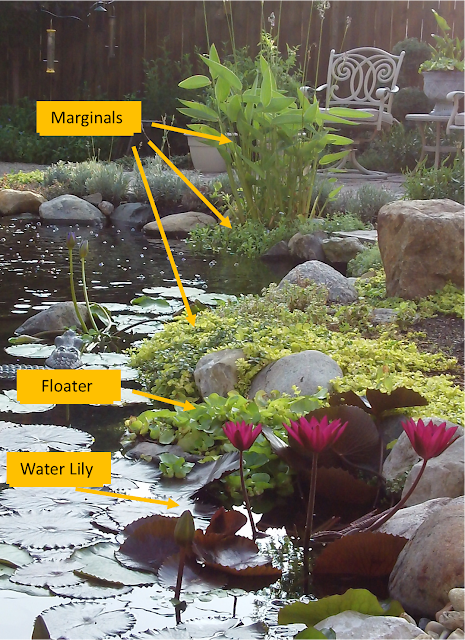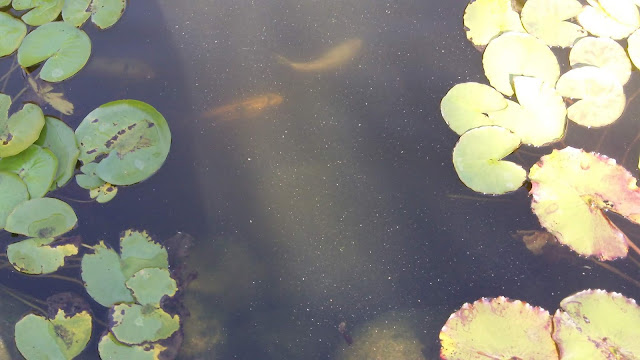Types of Aquatic Plants
Plants in the photo: Marginals: Thalia, Forget-me-not, Creeping Jenny
Floater: Water Hyacinth
Water Lily: Tropical Night Blooming -- Red Flare
Floater: Water Hyacinth
Water Lily: Tropical Night Blooming -- Red Flare
How do I know what aquatic plants to put in my pond (or pond-free or other type of water feature)? That is an excellent question that we get a lot!
Each type of aquatic plant has it's pros and cons. Let's break that down...
Water Lilies
Water lilies are planted on the bottom of the pond and send long stems to lily pads (leaves) that float on the water surface. In the right conditions, water lilies will produce large blooms above or at the water surface. Water lilies need a water depth of 1.5 to 2 feet.
Pros: Water lilies produce ample shade and protection for fish. They're beautiful!
Cons: (Not really a con), Water lilies do not compete with algae for food like other plants. Also water lilies need to be contained in a fabric bag or pot. They can be aggressive and will take over the bottom of the pond if not kept in check. They should be repotted every few years and need fertilizer to bloom profusely.
Cons: (Not really a con), Water lilies do not compete with algae for food like other plants. Also water lilies need to be contained in a fabric bag or pot. They can be aggressive and will take over the bottom of the pond if not kept in check. They should be repotted every few years and need fertilizer to bloom profusely.
In my opinion every pond should have a water lily -- if for nothing else their appearance. And besides, where would your frogs rest?
Marginals
Marginal plants are those that reside in the "margins" of the water feature. They are shallow water plants that have their roots in the water and the foliage above the water. A very commonly known marginal plant is a cattail. Marginal plants are perfect for naturalizing the pond edge. Marginal plants can be placed in most types of water features as long as there is a shallow area of only a few inches. Marginal plants are perfect for pond-free waterfalls.
Pros: Marginals are excellent at completing with algae for nutrients -- so they help keep string algae at bay and help keep the water clear. They need very little maintenance and come in all sizes, colors, and bloom times.
Cons: A few varieties can be invasive (horsetail rush) and those should be kept in pots to be contained. They need to be planted in shallow (just a few inches) water and unfortunately many people design their ponds without an area shallow enough.
No water feature should be without marginal plants if at all possible. The variety of colors, blooms, textures is amazing.
Floaters
Floating plants -- Water Hyacinth and Water Lettuce -- float on the surface of the water with their roots dangling below them. They need at least 4 to 5 inches of water.
Pros: Fantastic at cleaning water. They are used as sewage treatment in some areas of the world. They provide fast shade and cover for fish because they spread quickly.
Cons: Can be messy. Their roots shed and leave debris in the pond bottom. They also don't do well in clean water and will begin to yellow.
Personally I don't use floaters at home or at Cool Ponds. But for many people they're a quick, easy, inexpensive way to get aquatic plants in a water feature.
Submerged (not shown in the photo above)
Submerged plants grow on the pond bottom. (Think of a plant for freshwater that grows like seaweed.) Submerged plants are also referred to as oxygenators; but they use oxygen as well so don't buy them for that purpose. They don't flower. (Ok some do but those are illegal in Indiana.)
Pros: They clean the water similarly to floating plants. They are a great place for fish to spawn and for fry to hide. (For many people that might be a Con.) Mature pond fish can hide in submerged plants also.
Cons: They can easily take over a pond. They usually need to be replaced annually. As they die back in cooler water they will have to be removed before they decompose.
We do not sell submerged plants at Cool Ponds. Very few pond owners use them, I think because other plants can do what they do. I have never used them personally. If they don't also have the benefit of beautifying my pond, I'm not interested!
So these are the basic aquatic plants that are commonly used in water features. There are others of course, but if you know the plants described above, you'll be successful in planting your water feature.
Have fun with your planting. It's an easy way to add to and change your water feature as it matures.
Visit Cool Ponds from May - September for beautiful aquatic plants! See you soon!



Comments